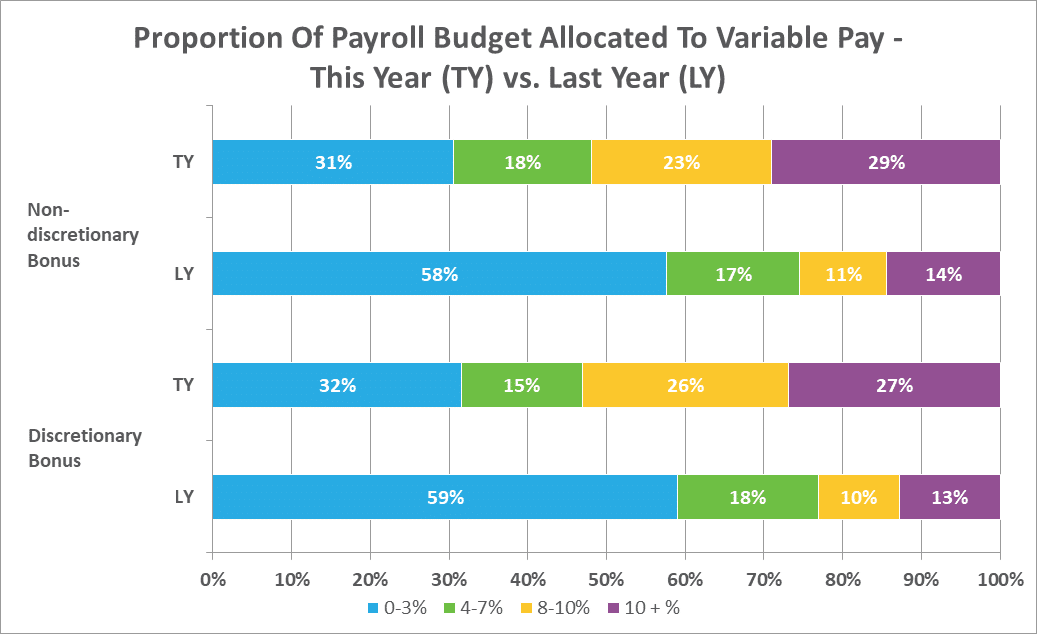The concept of performance-based pay is one with which most of us can identify. We grew up participating in spelling bees, playing competitive sports, and challenging our peers – there was always a winner. We carried this philosophy into other areas of our lives, pursuing school achievements and career goals. It’s instilled in us that those who work hard receive recognition and reward.
Seems pretty black and white, right? However, performance-related pay isn’t as cut and dry as giving a trophy to a competition winner; performance-based compensation has both pros and cons. And understanding them can help you decide whether or not your business should implement a merit-based pay system.
What is Performance-Based Pay?
Performance-based pay plans involve compensating employees for a specific outcome or work that goes above and beyond the typical call of duty. When designing a performance-based compensation system, common criteria include:
- Job category
- Length of service
- Job classification
- The goal of the incentive
- What the payout will consist of (e.g., bonus, stock, or cash)
There is a lot to consider when deciding whether to implement a performance-based pay structure. So, let’s take a look at the advantages and disadvantages of performance-based pay.

Advantages of Performance-Based Pay
Identify Areas for Improvement
By implementing a performance-based pay system, your company can quickly identify top-performing employees. You can also hone in on workers who may not be contributing as much to the company. Putting a quantifiable amount on an employee’s contributions can help you determine the reasons for varying performance levels.
Low-performance factors can include an ineffective training process, lack of accountability, and miscommunication from superiors about job expectations. Companies that use performance-based pay can identify areas in which their businesses can improve. Offering pay increases based on performance allows you to focus on individuals that need more guidance and strategize on change.
Another way to identify areas of improvement is to incorporate performance appraisals into your merit-based compensation plan. Performance appraisals may be conducted yearly, semi-annually, or even quarterly. They provide a valuable opportunity to discuss individual performance with your employees and create a customized growth plan. As the individual achieves their performance goals, the program monetarily rewards the employee.
Increase Retention
Performance-based pay models help employers differentiate between top and low performing employees. When top performers are paid a higher compensation rate and recognized for their performance, they are more inclined to remain with their organization. Employees on a compensation plan based on performance are more driven to reach goals and earn the extra money.
A performance-based compensation plan encourages more valuable contributors to continue their best work because they are paid fairly for their efforts. These workers are also more likely to become your biggest brand ambassadors and attract other qualified employees to your organization.
Better Recruiting
When companies can identify those employees who perform better, they can improve their recruiting processes. Instead of vetting and hiring employees who might not contribute to the organization, they can use data on their top performers to hire candidates with similar attributes, goals, and personalities.
This assessment process can save companies time and money by hiring top candidates from the start. Streamlining the recruiting process with more consistent hiring of people who are the right fit will also decrease turnover costs.
Disadvantages of Performance-based Pay

A Blurred Line
Unfortunately, it’s incredibly challenging to accurately and proportionally pay employees using this system. There is often a blurred line between job role expectations and levels of compensation. If you do not outline compensation and performance metrics precisely, there could be confusion and miscommunication about company expectations to reach compensation goals.
This confusion can lead to disgruntled and discouraged employees who are not receiving the pay they expected. Additionally, a blanket policy that encompasses your organization’s working departments is likely an inadequate one since work significantly differs company-wide.
Use tools that allow you to determine the appropriate compensation employees are entitled to based on experience, tenure, and education level. From there, you can decide what type of performance-based compensation structure might work for your employees.
Misalignment of Goals
For those employees who are top performers and receive additional compensation for their work, there is the possibility they could eventually reach a cap on their possible earnings. When employees are motivated solely by the incentive to receive a higher wage, this could become their only focus - forgetting about your organization’s goals.
In this situation, company missions, goals, and culture might be negatively affected by those whose contributions truly impact results. That’s why it’s essential to develop a performance-based compensation system that aligns with your organizations’ goals. This alignment ensures that everyone is working towards the same objectives and rewarded for meeting benchmarks.
The Threat of Dissolving Profits
Sometimes, companies use performance-based compensation to motivate employees without fully understanding the potential issues that could result. Weighing the pros and cons of performance-based compensation requires thorough research to evaluate fair pay for certain compensation levels.
Often, the allure of increased income incentivizes higher performance, which is all good and well. However, companies may lack a plan for when the cost begins to outweigh the benefits. If the promise of extra compensation causes your employees more stress and impacts their productivity, you may experience the law of diminishing returns.
That’s why it’s crucial to ensure a balance between the amount of work expected and the additional compensation. If the performance-based incentive is too small, it won’t motivate your staff to work harder. If it’s too large, the company’s profits could take a hit.
Want a Better Way to Manage Employee Pay?
Types of Performance-Based Pay
There are many different ways to create performance-based pay structures. Let’s take a look at the two general types of performance-based compensation:
1. Merit-Based Pay Increases
Merit pay increases, or merit bonuses, increase an employee’s base pay due to their high performance. They are generally budgeted for and given on an annual basis. Merit-based increases are the most common form of performance-based compensation.
However, according to Salary.com, the external market is progressing in pay faster than merit pay increases alone can match. Therefore, your top performers could potentially walk out the door for a more competitive salary.
2. Variable Pay Programs
Another type of performance-based compensation system is variable pay programs. These types of compensation plans based on performance consist of discretionary and non-discretionary bonuses. Variable pay programs are typically delivered multiple times throughout the year, such as quarterly.
Many companies use a combination of discretionary and non-discretionary bonuses to create a customized performance-based pay structure. The number of businesses committing at least 10% of their payroll budget towards discretionary and non-discretionary bonuses has more than doubled since 2017.


Performance-Based Pay Examples
Merit-Based Increase Example
Merit-based increases are typically a small percentage of an employee’s overall salary. The average merit increase is about three percent and given to employees on an annual basis. This percentage can vary from company to company and even from employee to employee, depending on performance.
Example
A three percent merit increase for an employee making a $50,000 annual salary in 2020 is an additional $1,500 per year. Therefore, this employee’s salary would increase to $51,500 in 2021.
Discretionary Bonus Examples
Discretionary bonuses reward employees on an as-needed basis when they demonstrate exceptional performance. They are usually rewarded without taking company goals into account and can include:
- Holiday Bonuses: These types of bonuses are awarded to employees to signify gratitude and appreciation at the end of the year. Typically, a holiday bonus is given equally to the entire staff.
- Project Bonuses: These types of bonuses are given to employees for completing outstanding work on a special project.
- Spot Bonuses: These types of bonuses reward employees for “on the spot” achievements that deserve recognition.
Example
If an employee making $60,000 a year receives a $3,000 retention bonus in 2021, their salary for that year is $63,000. This retention bonus would not impact that employee’s annual salary in 2022 unless they receive another one.
Non-Discretionary Bonus Examples
Non-discretionary bonuses reward employees, teams, or the entire company meets specific, pre-defined goals. Depending on how long the performance is measured, they may be considered short-term incentives or long-term incentives. These types of bonuses include:
Example
Let’s say an employee making $40,000 a year receives an incentive bonus of $1,000 in one out of four quarters for 2021. This incentive bonus means that the employee’s gross income for 2021 would be $41,000.
- Individual Incentive Bonuses: These types of bonuses are typically based on measurable and predetermined objectives evaluated during a specific period, such as quarterly.
- Team-Incentive Bonuses: These types of bonuses are focused on specific goals that must be met for an entire team and are rewarded based on that group’s performance.
- Company-Wide Bonuses: These types of bonuses are based on specific goals the entire organization meets at a particular time and awarded to all employees in the company.
Other Types of Bonuses
- Referral Bonus: This type of bonus is given to an employee who refers a qualified candidate for a job position. If the candidate is hired, the referring employee receives a bonus.
- Retention Bonus: This type of bonus is awarded to high-tenure employees or workers in competitive job roles to decrease their potential for leaving.
Example
An employee making $30,000 a year refers a qualified candidate for an open job position at their company. The organization hires the applicant, and they complete their 90-day onboarding period. The company’s referral bonus is $500, so the referring employee’s annual salary for that year is $30,500.
So, is Performance-Based Pay Effective?
Is performance-based pay effective? It can be an effective way to motivate your employees and reward them for being more productive. The advantages include increased employee retention, better recruiting, and higher performance.
However, it’s crucial to find the right balance between job role expectations and compensation. You don’t want to create a situation where your employees feel increased pressure to perform because they don’t want to lose out on additional compensation.
Understanding your company’s current compensation structure, employee hierarchy, and future goals is essential when determining if it’s right for you. A performance-based compensation system is not one size fits all, so consider a combination of merit increases and incentive bonuses. You want to engage your employees without creating a mindset to overwork themselves to meet goals and earn additional compensation.
If you’ve weighed the pros and cons of performance-based compensation and feel it’s the next step for your company, communicate with your employees, and analyze the potential costs. Ensure there are performance measurements in place to track the goals you’ve set for your workers and organization to ensure an effective, smooth performance-based compensation structure.
How APS Can Help
APS provides an all-in-one platform for managing payroll and HR processes. HR professionals can manage and track performance-based compensation plans to ensure employees are rewarded for their contributions. With performance management, HR managers can also stay focused on employee accomplishments.
Set goals to maintain staff accountability and boost employee engagement. Organizations can eliminate miscommunication, foster company-wide and individual visibility, and promote growth. For more information, please call 855-511-0084.



